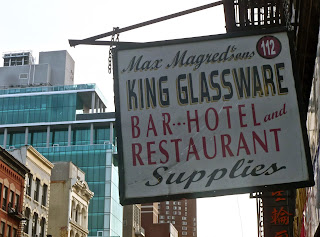James and Karla Murray, the photographers who brought us the wonderful book
Store Front: The Disappearing Face of New York, have been quietly working on an exciting new project.
One by one, they are revisiting all the store fronts they photographed a decade ago and taking new pictures. In the process, they're creating a dramatic and often heartbreaking visual representation of
hyper-gentrification. In just about a decade, much of the city's streetscape has changed significantly, shifting in two general directions -- to upscale businesses and condos, or to chain stores and banks.
It's a startling view of the city before and after Bloomberg.
I asked the Murrays a few questions about their
"before and after" project.
 all photos James & Karla Murray: see more here
What inspired you to embark on this project?
all photos James & Karla Murray: see more here
What inspired you to embark on this project?
We embarked on the before-and-after project when over 10 years had passed since we had initially started photographing the mom-and-pop stores, an amount of time which really started to bring into focus the loss of character and decreased sense of community the neighborhoods undergoing these changes had.
While finishing our Store Front book in 2008, we chose the front and back cover photos expressly because those businesses had been forced to close. Ralph’s Discount City in TriBeCa was forced to close in 2007 when the building began plans for conversion into a luxury condo. Katy’s Candy Store in Bed-Stuy also closed in 2007 after the owner planned to convert the building into luxury apartments, which sadly never happened after the economic downturn, and the retail space remains vacant today. Zito & Sons Bakery on Bleecker Street in Greenwich Village closed in 2004 and the tiny storefront remained vacant for years.
 As you're going through this project, what trends are you seeing in terms of changes?
As you're going through this project, what trends are you seeing in terms of changes?
The trend we noticed very early on while photographing the original stores was that if the owner did not own the building, their business was in jeopardy of closing. The owners frequently acknowledged that they were at the mercy of their landlords and the ever-increasing rents they charged.
Due to the commonality of high rent increases starting in the early 2000s, after the small business was forced to close, it was often replaced by a chain-type store or banking institution, which could afford the higher rent, or the whole building was converted into a luxury condo. If the location was too small, or the locale was deemed undesirable by a chain-type store, the space often remained vacant, sometimes for years.
 What have been the most startling changes you've seen? What changes -- or non-changes -- have you been pleased to see?
What have been the most startling changes you've seen? What changes -- or non-changes -- have you been pleased to see?
When the original 2nd Avenue Deli in the East Village closed in 2006 after the rent was increased from $24,000 a month to $33,000 a month, and a Chase Bank took over the space, we knew the contrast of before and after was severe.
Another startling change in the East Village was the closure of CBGB in 2006 after it lost its lease. It was replaced by a high-end fashion boutique, John Varvatos, which initially to us seemed out-of-place on the Bowery.
No iconic locale seemed safe any longer. Just like with CBGB’s, we were shocked when Lenox Lounge in Harlem closed on December 31, 2012, after a lease dispute. The East Village’s Mars Bar closed in 2011, was torn down, and replaced by a luxury condo with a soon-to-be-opened TD Bank on the ground floor space.
We are happy to see that in certain instances, a small business is replaced by a new small business, but it doesn’t seem to happen as often as we would like. A good example of this is E. Kurowycky & Sons Meat Market in the East Village, which closed in 2007 and was replaced by Kim’s Video.
 Looking at the before and after images side by side, what does this lead you to conclude about change in the city as a whole over the past 10 - 15 years?
Looking at the before and after images side by side, what does this lead you to conclude about change in the city as a whole over the past 10 - 15 years?
The purpose of the photos in the before-and-after project is to clearly spell out and provide documentation of not only what storefronts have been lost, but also what is often lacking in the commercial space’s replacement. Until you place them side-by-side and really look at the two photos, you cannot get the true sense of loss experienced by the neighborhood.
We hope this glimpse will bring awareness to the unique character these small mom-and-pop businesses add to the streets and neighborhoods of New York City and the sense of community they provide.

See Also:
Hyper-Gentrification
Master List of Vanishings
Meatpacking Before & After






















































